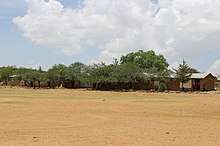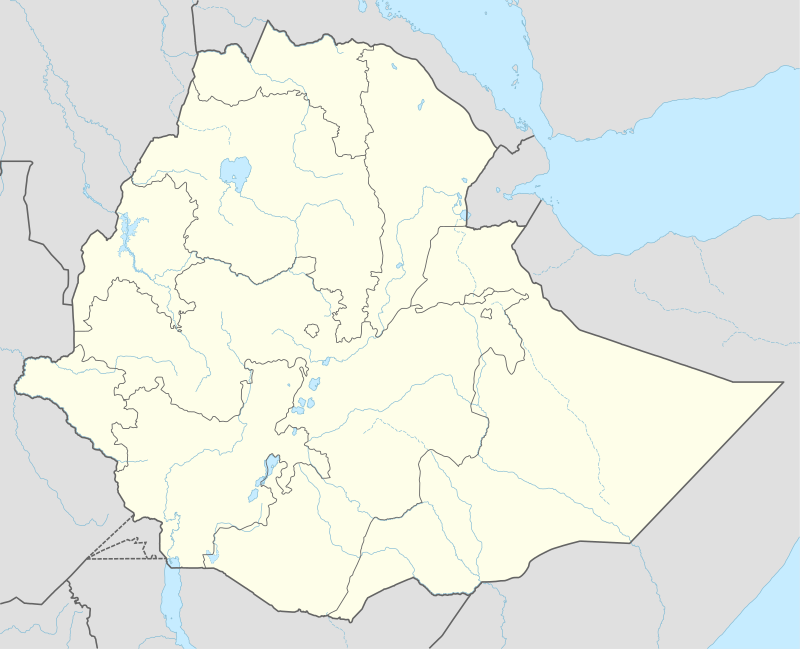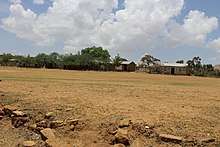Amanit school
Amanit School is a public school for grades 1 through 8 in Segenet, Amanit, Dogu’a Tembien, Tigray, Ethiopia. There are also a “zero” (pre-schooling) and an “alpha” grade class (uptake of adolescents who missed school so far).[1]
| Amanit school ኣማኒት ቤት ትምህርቲ | |
|---|---|
 | |
| Location | |
 Amanit school | |
Segenet Amanit municipality , | |
| Coordinates | 13.568°N 39.258°E |
| Information | |
| Type | Public School |
| School district | Dogu’a Tembien |
| Staff | 17 teachers |
| Grades | 1 – 8 |
| Gender | Co-Educational |
| Number of students | 422 |
| Language | Tigrinya, English |
| Data pertaining to | 2019[1] |
Description

The Amanit School has five classrooms. As of 2019, the school had 422 students, 224 girls and 188 boys.[1] There were:
- 52 students in one class in Grade 1
- 61 students in one class in Grade 2
- 45 students in one class in Grade 3
- 58 students in one class in Grade 4
- 49 students in one class in Grade 5
- 36 students in one class in Grade 6
- 31 students in one class in Grade 7
- 25 students in one class in Grade 8
- 33 students in one class in Grade 0
- 22 students in one class in Grade alpha
Over the last 20 years, important efforts have been done to increase schooling in Tigray, particularly of girls.[2] The large intake in primary schools in Ethiopia over the last decades has led to lack of classrooms.[3] Hence, classes take place through shifts (morning and afternoon).
Water and sanitation
In 2019, water was not available at the school. The hand-dug well with handpump on the schoolyard was broken, and the Gudeli village pump yields insufficient water, even for the village households. Up to 2019, there was no toilet building, the students went outside for toilet, boys and girls in separate directions.[1] There were also no specific facilities for girls handling menstrual hygiene;[1] this is a major reason for adolescent girls dropping out from school.[4][5][6]
In 2020, the School WatSani project has built an Ecosan toilet building at this school.[7][8] Through nudging approach, the students are sensitised for using the sanitation and water facilities.[7]
Transportation
All children travel to school on foot. Many students will walk more than an hour (some even two hours), twice a day, to come to school.[9]
See also
- Education in Ethiopia
- List of schools by country
- List of universities and colleges in Ethiopia
References
- Jeroen Berloo, 2019. Update to baseline study about water and sanitation in eight selected schools by the project ‘School – Watsani’ in the Woreda Dogu’a Tembien. HOWest, Bruges, Belgium.
- Mjaaland, T., 2013. At the frontiers of change? Women and girls’ pursuit of education in north-western Tigray, Ethiopia. The University of Bergen. http://bora.uib.no/handle/1956/6361
- Hartjen, C.A. and Priyadarsini, S., 2012. Denial of Education. In The Global Victimization of Children (pp. 271-321). Springer, Boston, MA. https://link.springer.com/chapter/10.1007/978-1-4614-2179-5_8 .
- Socio-demographic profile, food insecurity and food-aid based response. In: Geo-trekking in Ethiopia's Tropical Mountains - The Dogu'a Tembien District. SpringerNature. 2019. ISBN 978-3-030-04954-6.
- Wilberg, J., 2004. Female education in Tigray, Ethiopia. UMB, Norway. p. 104 http://www.umb.no/statisk/noragric/publications/master/2004_jeanett_wilberg.pdf
- What do we hear from the farmers in Dogu'a Tembien? [in Tigrinya]. Hagere Selam, Ethiopia. 2016. p. 100.
- Griet Verrewaere, 2019. Report of latrine use and behaviour amongst students - The nudging approach at School-Watsani. HOWest, Bruges, Belgium.
- Reubens, B. and colleagues (2019). Research-Based Development Projects in Dogu'a Tembien. In: Geo-trekking in Ethiopia's Tropical Mountains — The Dogu'a Tembien District. SpringerNature. doi:10.1007/978-3-030-04955-3_30. ISBN 978-3-030-04954-6.
- Goele Treuttens and Linde Van Der Vurst, 2018. Baseline study about water and sanitation in ten selected schools by the project ‘School – Watsani’ and in the community around the schools in ten different villages in the Woreda Dogu’a Tembien. HOWest, Bruges, Belgium.